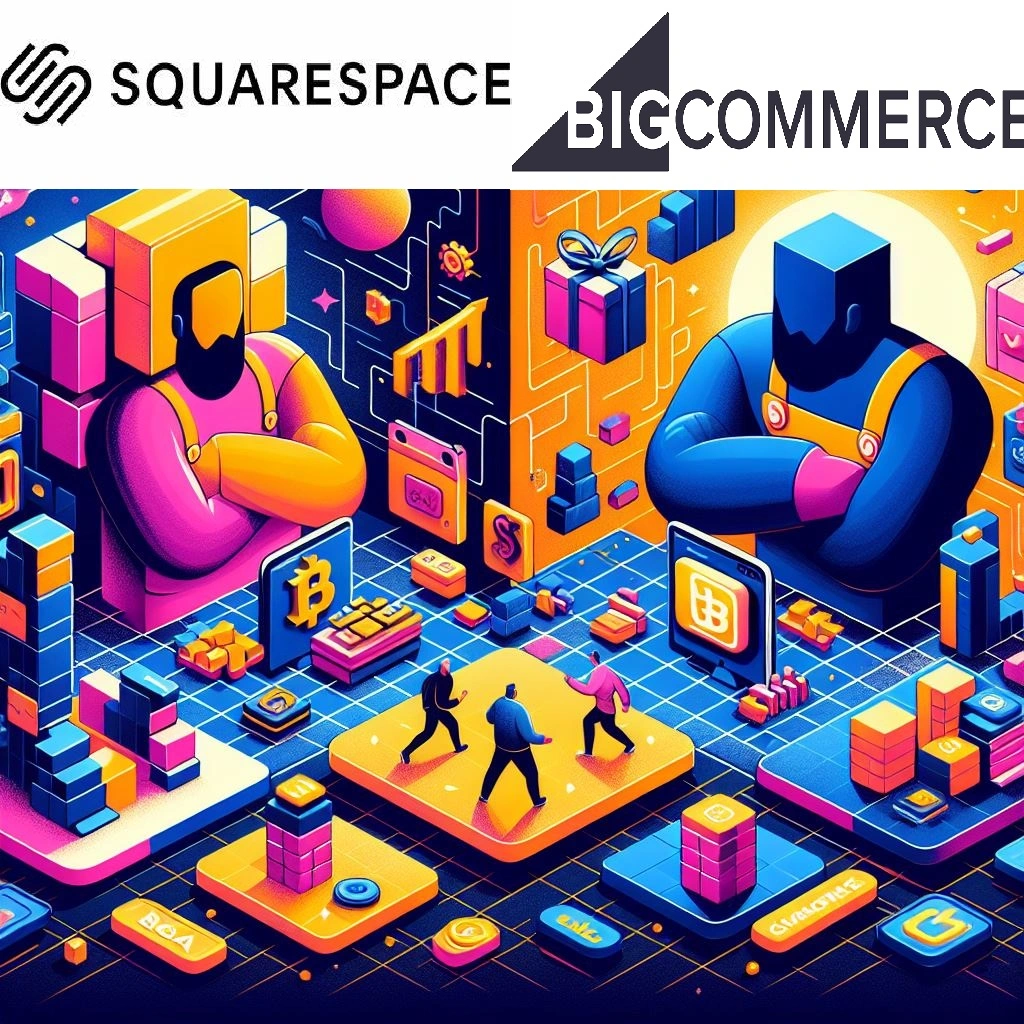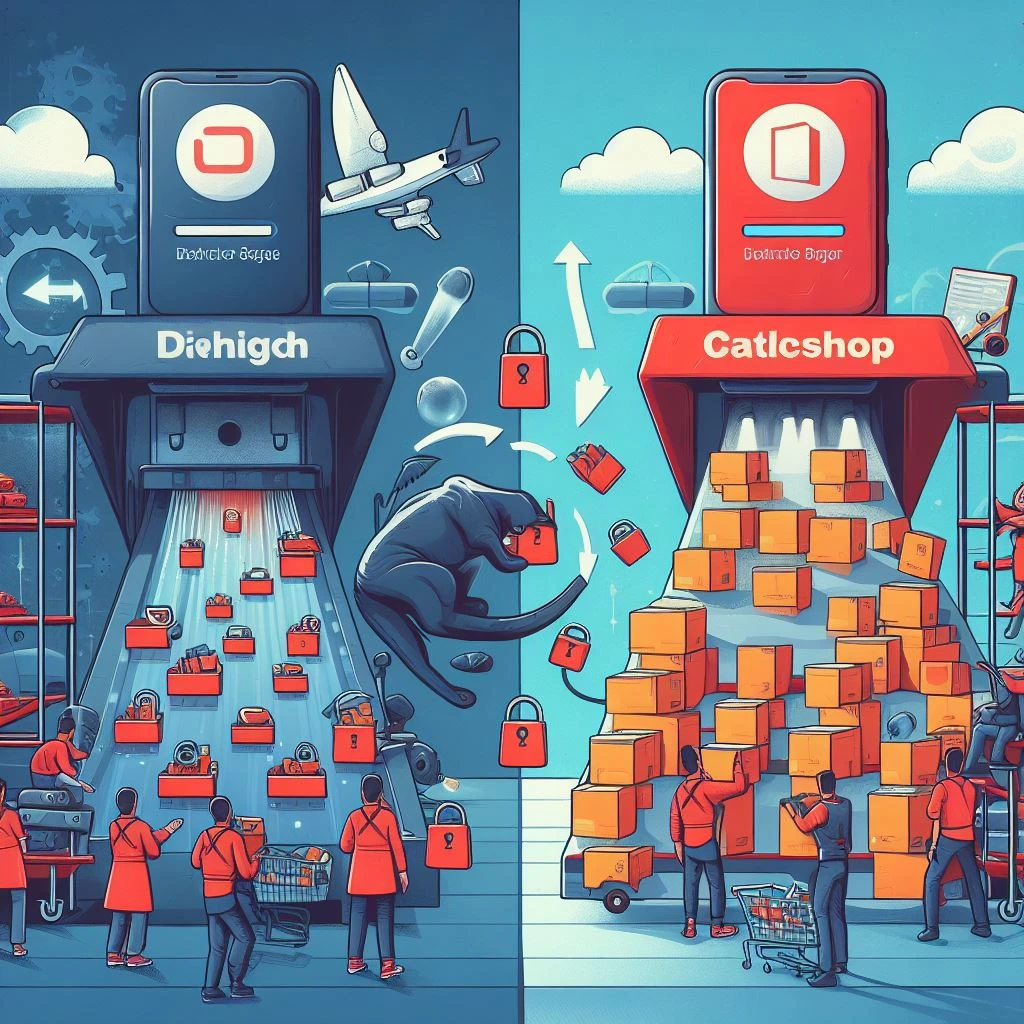In order to decide which ecommerce platform to use, BigCommerce vs Squarespace. A detailed comparison between features must be thoroughly done. If you want to decide which eCommerce platform to choose, there are many things to consider.
These are some examples of these factors:
- Cost.
- SEO friendliness.
- Page load speed.
- Canonical website URL.
- Indexing Control.
- Customizable HTML capabilities.
- Sitemap Generator.
- Integration with Google Analytics.
- Product Tagging and Categorization.
- Batch Uploading.
- Mobile Optimization.
- Built-in Blogging and Marketing Features.
- Social Sharing Buttons.
- Content Management Capabilities.
- Discount and promotion code tools.
- Easy to use Checkout.
- Reporting tools and custom reports.
- Integration of email marketing tools.
- Multiple payment options.
- Flexibility to add new eCommerce features.
- Exclusive features.
- Cons and pros.
Here we’ll discuss these factors to help you decide which platform is better for you, SquareSpace or BigCommerce. And at the end of the discussion, we’ll recap and make a comparison for the scores of all these points to find out which eCommerce platform has the higher score, so that you’ll have a good view about both of them.
Pricing (BigCommerce vs SquareSpace):

BigCommerce and Squarespace are both popular eCommerce platforms with different pricing structures.
BigCommerce offers four tiered pricing plans based on your annual gross merchandise value (GMV):
- Standard: $29.95 per month for up to $50,000 in annual GMV
- Plus: $79.95 per month for up to $150,000 in annual GMV
- Pro: $299.95 per month for up to $400,000 in annual GMV
- Enterprise: Custom pricing for businesses with over $400,000 in annual GMV
In addition to the monthly fee, BigCommerce also charges a transaction fee of 1.5% to 2.9% for transactions processed through its built-in payment gateway.
Squarespace offers three tiers of eCommerce pricing:
- Basic Commerce: $23 per month for up to $5,000 in annual sales
- Business Commerce: $33 per month for unlimited sales
- Advanced Commerce: $65 per month for unlimited sales and advanced features
All Squarespace eCommerce plans include a free SSL certificate, fraud protection, and abandoned cart recovery. Squarespace does not charge any transaction fees.
Here is a table that summarizes the pricing of BigCommerce and Squarespace:
| Feature | BigCommerce | Squarespace |
|---|---|---|
| Monthly fee | Starts at $29.95 | Starts at $23 |
| Transaction fees | 1.5% to 2.9% | None |
| Maximum annual sales | Unlimited | Unlimited |
| Free SSL certificate | Yes | Yes |
| Fraud protection | Yes | Yes |
| Abandoned cart recovery | Yes | Yes |
| Advanced features | Only available on higher-tier plans | Available on all plans |
Overall, BigCommerce is a more expensive platform than Squarespace, but it offers more features and is better suited for businesses with high annual sales volumes. Squarespace is a good choice for businesses with low to moderate sales volumes who want a simple and easy-to-use platform.
SEO Capabilities (BigCommerce vs SquareSpace):

BigCommerce vs SquareSpace vs eCommerce – SEO Capabilities
(BigCommerce vs SquareSpace)
Both BigCommerce and Squarespace offer a range of SEO capabilities to help you optimize your online store for search engines. However, BigCommerce generally offers more advanced SEO features and greater control over your SEO settings.
BigCommerce SEO Capabilities
- Pre-built SEO meta tags: BigCommerce automatically generates meta tags for your product pages, category pages, and blog posts.
- Customizable meta tags: You can customize the meta tags for your pages to give search engines more information about your content.
- Structured data markup: BigCommerce supports structured data markup, which helps search engines understand the content of your pages.
- URL structure control: You can control the URL structure of your pages to make them more SEO-friendly.
- Image optimization tools: BigCommerce provides tools to optimize your images for search engines.
- 301 redirects: You can create 301 redirects to ensure that your pages are properly indexed by search engines.
- robots.txt file editing: You can edit your robots.txt file to control how search engines crawl your website.
- Sitemaps: BigCommerce automatically generates sitemaps for your website.
- SEO reporting: BigCommerce provides SEO reporting to help you track your progress.
Squarespace SEO Capabilities
- Pre-built SEO meta tags: Squarespace automatically generates meta tags for your product pages, category pages, and blog posts.
- Customizable meta tags: You can customize the meta tags for your pages to give search engines more information about your content.
- Structured data markup: Squarespace supports structured data markup, which helps search engines understand the content of your pages.
- URL structure control: You can control the URL structure of your pages to make them more SEO-friendly.
- Image optimization tools: Squarespace provides tools to optimize your images for search engines.
- 301 redirects: You can create 301 redirects to ensure that your pages are properly indexed by search engines.
- robots.txt file editing: You can edit your robots.txt file to control how search engines crawl your website.
- Sitemaps: Squarespace automatically generates sitemaps for your website.
- SEO reporting: Squarespace provides limited SEO reporting.
Overall, BigCommerce offers more advanced SEO features and greater control over your SEO settings than Squarespace. However, Squarespace’s SEO capabilities are still good for basic SEO needs.
PageLoad Speed (BigCommerce vs SqaureSpace):

Sure, here is a summary of page load speed for BigCommerce and Squarespace, along with a comparison table:
Page Load Speed Summary
Both BigCommerce and Squarespace offer a variety of features to help improve page load speed. However, BigCommerce generally has a faster average page load speed than Squarespace.
BigCommerce Page Load Speed Features
- Content Delivery Network (CDN): BigCommerce uses a CDN to deliver your website’s content to visitors from around the world. This can help improve page load speed for visitors who are located far from your website’s servers.
- Image optimization: BigCommerce provides tools to optimize your images for faster loading times.
- Minification: BigCommerce automatically minifies your website’s code, which can help improve page load speed.
- Lazy loading: BigCommerce supports lazy loading, which means that images are not loaded until they are visible to the visitor. This can help improve page load speed for longer pages.
Squarespace Page Load Speed Features
- CDN: Squarespace uses a CDN to deliver your website’s content to visitors from around the world.
- Image optimization: Squarespace provides tools to optimize your images for faster loading times.
- Minification: Squarespace automatically minifies your website’s code.
- Lazy loading: Squarespace supports lazy loading.
Page Load Speed Comparison Table
| Platform | Average Page Load Speed (Desktop) | Average Page Load Speed (Mobile) |
|---|---|---|
| BigCommerce | 2.32 seconds | 8.709 seconds |
| Squarespace | 2.08 seconds | 8.5 seconds |
Overall, BigCommerce has a faster average page load speed than Squarespace. However, Squarespace’s page load speeds are still good. Both platforms offer a variety of features to help improve page load speed, so you should be able to get good results with either platform.
Canonical Website URL (BigCommerce vs SquareSpace):

Here is a summary of canonical website URL capabilities for BigCommerce and Squarespace, along with a comparison table:
Canonical Website URL Capabilities Summary
Both BigCommerce and Squarespace offer canonical URL implementation, a crucial SEO technique for preventing duplicate content issues. While both platforms provide this feature, there are some key differences in their implementation and usage.
BigCommerce Canonical URL Capabilities
- Automatic Canonical URL Generation: BigCommerce automatically generates canonical URLs for product pages, category pages, and blog posts. This eliminates the need for manual intervention, ensuring consistency and preventing duplicate content issues.
- Custom Canonical URL Settings: For more control, BigCommerce allows users to customize canonical URLs for specific pages. This flexibility enables advanced SEO strategies and tailored URL optimization.
- Comprehensive Canonical URL Coverage: BigCommerce’s canonical URL implementation extends to various page types, including product pages, category pages, blog posts, and custom pages, ensuring wide-ranging coverage for SEO optimization.
Squarespace Canonical URL Capabilities
- Manual Canonical URL Creation: Squarespace requires users to manually create canonical URLs for each page. While this allows for precise control, it can be time-consuming and may lead to inconsistencies or missed pages.
- Limited Canonical URL Scope: Squarespace’s canonical URL implementation primarily focuses on product pages and blog posts, with limited support for other page types. This may restrict SEO optimization opportunities for certain content.
Canonical URL Comparison Table
| Feature | BigCommerce | Squarespace |
|---|---|---|
| Canonical URL Generation | Automatic | Manual |
| Customizable Canonical URLs | Yes | Yes |
| Canonical URL Coverage | Comprehensive | Limited |
| Ease of Implementation | Easier | More complex |
Overall, BigCommerce offers a more comprehensive and user-friendly approach to canonical URL implementation compared to Squarespace. Its automatic generation, custom settings, and wide-ranging coverage make it a more powerful tool for SEO optimization.
Indexing Control (BigCommerce vs SquareSpace):

Indexing Control: BigCommerce vs Squarespace
Both BigCommerce and Squarespace provide some level of control over how search engines index your website. Here’s a comparison of their indexing control capabilities:
BigCommerce:
- Robots.txt: Allows you to block specific pages or folders from being indexed by search engines.
- Meta robots tags: Allows you to specify how individual pages or sections of pages should be indexed.
- Dynamic content control: Lets you choose whether or not dynamic content, such as product variations and search results, is indexed.
- Noindex parameter: Can be added to URLs to prevent them from being indexed by search engines.
- Product page indexing: You can choose to individually index or hide product pages from search engines.
Squarespace:
- Robots.txt: Offers limited control over robots.txt settings, mainly focusing on basic configuration.
- Meta robots tags: Limited options for customizing how individual pages or sections are indexed.
- Dynamic content control: Offers limited control over indexing dynamic content.
- Noindex parameter: Not readily available, requiring custom code implementation for advanced users.
- Product page indexing: All product pages are automatically indexed by default, with no individual control option.
Comparison Table:
| Feature | BigCommerce | Squarespace |
|---|---|---|
| Robots.txt | Extensive control | Limited control |
| Meta robots tags | Flexible customization | Limited options |
| Dynamic content control | Granular control | Limited control |
| Noindex parameter | Available | Not readily available |
| Product page indexing | Individual control | Automatic indexing |
Overall:
BigCommerce offers significantly more control over indexing compared to Squarespace. It provides a wider range of options and tools for managing how search engines crawl and index your website.
Customizable HTML Capabilities (BigCommerce vs SquareSpace):

Customizable HTML Capabilities: BigCommerce vs Squarespace
When it comes to customizing your online store with HTML, both BigCommerce and Squarespace offer varying levels of flexibility and control. Here’s a breakdown of their capabilities:
BigCommerce:
- Extensive HTML/CSS access: BigCommerce offers extensive access to your store’s HTML and CSS code, allowing for deep customization of your website’s design and functionality. You can edit themes directly, create custom templates, and inject custom code for advanced features.
- Code editor: BigCommerce provides a built-in code editor with syntax highlighting and other features to facilitate code editing directly within the platform.
- Theme development tools: BigCommerce offers a set of tools and resources for developers to build custom themes and extensions, allowing for even greater customization flexibility.
Squarespace:
- Limited HTML/CSS access: Squarespace offers limited access to your website’s HTML and CSS code, primarily through injecting code blocks into specific sections of your website. You cannot directly edit themes or create custom templates.
- Code injection: Squarespace allows you to inject custom HTML, CSS, and JavaScript code into specific sections of your website, but this requires advanced coding knowledge.
- Limited customization options: Squarespace’s drag-and-drop interface offers a user-friendly approach for basic website design but restricts customization options for users who prefer deeper control using code.
Comparison Table:
| Feature | BigCommerce | Squarespace |
|---|---|---|
| HTML/CSS access | Extensive | Limited |
| Code editor | Built-in | Requires code injection |
| Theme customization | Deep customization possible | Limited customization options |
| Theme development tools | Available | Not available |
Overall:
BigCommerce offers significantly more flexibility and control for customizing your website with HTML compared to Squarespace. If you are comfortable with coding and require extensive customization options, BigCommerce is the clear choice. However, if you prefer a user-friendly platform with limited coding requirements, Squarespace might be a better option for basic customization needs.
Sitemap Generators (BigCommerce vs SquareSpace):

Sitemap Generators: BigCommerce vs Squarespace
Both BigCommerce and Squarespace offer features for generating sitemaps, which play a crucial role in search engine optimization (SEO) by providing search engines with information about the structure and content of your website. Here’s a comparison of their sitemap generation capabilities:
BigCommerce:
- Automatic sitemap generation: BigCommerce automatically generates a sitemap that includes all of your website’s pages. This ensures that search engines are aware of all your content and can properly crawl and index your website.
- Customizable sitemap settings: You can customize the settings for your sitemap, such as the frequency of updates and the inclusion of specific pages or sections.
- Sitemap submission tools: BigCommerce provides tools for submitting your sitemap to major search engines, such as Google and Bing.
- Support for dynamic content: BigCommerce can automatically include dynamic content, such as product variations and search results, in your sitemap.
Squarespace:
- Automatic sitemap generation: Squarespace also automatically generates a sitemap of your website’s pages.
- Limited customization options: Squarespace offers limited options for customizing your sitemap settings.
- No built-in submission tools: Squarespace does not provide built-in tools for submitting your sitemap to search engines. However, you can manually submit your sitemap using the search engines’ webmaster tools.
- Limited support for dynamic content: Squarespace’s sitemap generation may not always include dynamic content effectively.
Comparison Table:
| Feature | BigCommerce | Squarespace |
|---|---|---|
| Automatic generation | Yes | Yes |
| Customization | Flexible | Limited |
| Submission tools | Yes | No |
| Dynamic content support | Yes | Limited |
Overall:
BigCommerce offers a more comprehensive and customizable sitemap generation solution compared to Squarespace. BigCommerce’s automatic generation, customizable settings, submission tools, and support for dynamic content make it a more powerful tool for SEO optimization.
Integration With Google Analytics (BigCommerce vs SquareSpace):

Integration with Google Analytics: BigCommerce vs Squarespace
Both BigCommerce and Squarespace offer integrations with Google Analytics, a powerful tool for tracking website traffic and analyzing user behavior. Here’s a comparison of their integration capabilities:
BigCommerce:
- Native integration: BigCommerce offers a native integration with Google Analytics, making it easy to connect your store to Google Analytics and start tracking website data.
- Enhanced eCommerce tracking: BigCommerce supports enhanced eCommerce tracking, which provides detailed data about your online store’s performance, including product views, add-to-cart events, and purchases.
- Customizable dashboards: BigCommerce allows you to create custom dashboards in Google Analytics to track key metrics and insights that are relevant to your business.
- Advanced data analysis: BigCommerce provides access to advanced data analysis tools in Google Analytics, such as custom dimensions and metrics, which can help you gain deeper insights into your website’s performance.
Squarespace:
- Third-party integration: Squarespace requires a third-party integration tool, such as Glew, to connect your website to Google Analytics.
- Basic eCommerce tracking: Squarespace supports basic eCommerce tracking, which provides data about website traffic and purchases. However, it may not offer the same level of detail as BigCommerce’s enhanced eCommerce tracking.
- Limited data analysis: Squarespace’s integration with Google Analytics provides limited data analysis tools. You may need to use additional tools or services to get deeper insights into your website’s performance.
Comparison Table:
| Feature | BigCommerce | Squarespace |
|---|---|---|
| Integration type | Native | Third-party |
| eCommerce tracking | Enhanced | Basic |
| Data analysis | Advanced | Limited |
| Custom dashboards | Supported | Not supported |
Overall:
BigCommerce offers a more robust and comprehensive integration with Google Analytics compared to Squarespace. Its native integration, enhanced eCommerce tracking, customizable dashboards, and advanced data analysis tools make it a more powerful choice for businesses that need to track and analyze their website’s performance in detail.
Product Tagging and Categorization (BigCommerce vs SquareSpace):

Product Tagging and Categorization: BigCommerce vs Squarespace
Product tagging and categorization play a crucial role in online stores, helping customers find products more easily and improving search engine optimization (SEO). Here’s a comparison of BigCommerce and Squarespace’s capabilities in this area:
BigCommerce:
- Extensive product tagging options: BigCommerce allows you to add multiple tags to each product, which can be based on various criteria such as color, size, brand, material, and more.
- Hierarchical category structure: You can create a hierarchical category structure to organize your products efficiently. This allows for nested categories and subcategories to facilitate easier navigation for customers.
- Automatic tag suggestions: BigCommerce helps you discover and add relevant tags to your products based on existing product data and customer search behavior.
- SEO-friendly URL generation: Product URLs automatically incorporate tags and categories, making them easier for search engines to understand and rank.
Squarespace:
- Limited product tagging options: Squarespace allows you to add a few tags to each product, but the options are more limited compared to BigCommerce.
- Simple category structure: Squarespace offers a basic category structure with limited nesting capabilities. This can make it challenging to organize a large inventory efficiently.
- Manual tag creation: You need to manually add tags to each product in Squarespace, which can be time-consuming for large stores.
- Limited SEO optimization: Product URLs in Squarespace do not automatically incorporate tags and categories, potentially impacting SEO performance.
Comparison Table:
| Feature | BigCommerce | Squarespace |
|---|---|---|
| Product tagging | Extensive | Limited |
| Category structure | Hierarchical | Simple |
| Tag suggestions | Automatic | Manual |
| SEO-friendly URLs | Yes | Limited |
Overall:
BigCommerce offers significantly more powerful and flexible product tagging and categorization features compared to Squarespace. Its extensive tagging options, hierarchical category structure, automatic tag suggestions, and SEO-friendly URL generation make it a better choice for stores that require a robust and organized product navigation system.
Batch Uploading (BigCommerce vs SquareSpace):

Batch Uploading: BigCommerce vs Squarespace
Batch uploading allows you to import large quantities of products, categories, and other data into your online store quickly and efficiently. Here’s a comparison of BigCommerce and Squarespace’s batch uploading capabilities:
BigCommerce:
- Supports multiple data formats: BigCommerce supports various data formats for batch uploading, including CSV, XLSX, and JSON. This makes it compatible with most spreadsheet software and data management tools.
- Detailed import templates: BigCommerce provides detailed import templates that guide you through the process of formatting your data for batch uploading.
- Import validation tools: BigCommerce includes tools for validating your import data before uploading it. This helps prevent errors and ensures a smooth import process.
- Partial import support: BigCommerce allows you to import only specific data fields, even if your source file contains additional information.
- Scheduled imports: You can schedule batch imports to run automatically at a specific time or date. This can be helpful for recurring updates or large data imports.
Squarespace:
- Limited data format support: Squarespace primarily supports CSV files for batch uploading.
- Basic import templates: Squarespace provides basic import templates that may not be as detailed as BigCommerce’s templates.
- Limited import validation: Squarespace offers limited tools for validating your import data. This can increase the risk of errors and delays during the import process.
- Limited data field selection: Squarespace may not allow you to import specific data fields, depending on the type of data you are importing.
- No scheduled import capabilities: Squarespace does not offer scheduled imports.
Comparison Table:
| Feature | BigCommerce | Squarespace |
|---|---|---|
| Data format support | Multiple formats (CSV, XLSX, JSON) | Primarily CSV |
| Import templates | Detailed | Basic |
| Import validation | Extensive | Limited |
| Partial import | Supported | Limited |
| Scheduled imports | Supported | Not supported |
Overall:
BigCommerce offers significantly more robust and flexible batch uploading capabilities compared to Squarespace. Its support for multiple data formats, detailed import templates, extensive import validation tools, partial import support, and scheduled imports make it a better choice for managing large product catalogs and efficiently importing data into your online store.
Mobile Optimization (BigCommerce vs SquareSpace):

Mobile Optimization: BigCommerce vs Squarespace
Mobile optimization is crucial for online stores, as a significant portion of online traffic originates from mobile devices. Here’s a comparison of BigCommerce and Squarespace’s capabilities in mobile optimization:
BigCommerce:
- Responsive themes: BigCommerce offers a wide range of responsive themes that automatically adapt to different screen sizes and devices, ensuring an optimal shopping experience for mobile users.
- Mobile-first design principles: BigCommerce themes are built with mobile users in mind, prioritizing fast loading times, intuitive navigation, and clear product information.
- AMP support: BigCommerce supports Accelerated Mobile Pages (AMP), which offers a faster and more streamlined experience for mobile users, potentially improving conversion rates.
- Mobile app for store management: BigCommerce offers a mobile app for managing your store on the go, allowing you to check orders, update products, and respond to customer inquiries from your mobile device.
Squarespace:
- Responsive themes: Squarespace also offers responsive themes that adapt to different screen sizes. However, the selection of mobile-optimized themes might be smaller compared to BigCommerce.
- Mobile-friendly design: Squarespace themes are designed to be mobile-friendly, but the focus might not be as strong on mobile-first principles as BigCommerce.
- Limited AMP support: Squarespace only offers limited support for AMP, mainly focusing on blog posts rather than product pages.
- Mobile app for limited management: Squarespace offers a mobile app for basic store management, but the functionality might be limited compared to BigCommerce’s app.
Comparison Table:
| Feature | BigCommerce | Squarespace |
|---|---|---|
| Responsive themes | Wide range | Smaller selection |
| Mobile-first design | Yes | Limited focus |
| AMP support | Extensive | Limited |
| Mobile app functionality | Full store management | Basic management |
Overall:
BigCommerce offers a more comprehensive approach to mobile optimization compared to Squarespace. Its extensive selection of mobile-optimized themes, mobile-first design principles, AMP support, and comprehensive mobile app offer a superior mobile shopping experience for your customers and provide greater control for managing your store from your mobile device.
Built-in Blogging & Marketing Features (BigCommerce vs SquareSpace):

Built-in Blogging and Marketing Features: BigCommerce vs Squarespace
Both BigCommerce and Squarespace offer built-in blogging and marketing features to help you create content, promote your store, and engage with customers. However, there are some key differences in their capabilities:
BigCommerce:
- Basic blogging platform: BigCommerce offers a basic blogging platform with features like scheduling posts, adding images and videos, and managing comments. However, it lacks advanced blogging features like social media sharing, email marketing integration, and SEO optimization tools.
- Limited marketing features: BigCommerce provides some marketing features like abandoned cart emails, discount codes, and customer segmentation. However, it lacks advanced marketing automation tools, social media management tools, and email marketing campaigns.
- Requires integrations: To access more advanced blogging and marketing features, BigCommerce requires integrations with third-party apps, which may incur additional costs.
Squarespace:
- Comprehensive blogging platform: Squarespace offers a robust blogging platform with features like scheduling posts, social media sharing, email marketing integration, and SEO optimization tools.
- Extensive marketing features: Squarespace provides a range of built-in marketing features, including email campaigns, social media management tools, targeted popups, and landing pages.
- Integrations available: Squarespace integrates with various third-party apps for additional functionality, but many essential features are included in the platform itself.
Comparison Table:
| Feature | BigCommerce | Squarespace |
|---|---|---|
| Blogging platform | Basic | Comprehensive |
| Marketing features | Limited | Extensive |
| Integrations | Required for advanced features | Primarily included in platform |
| Social media integration | Limited | Built-in |
| Email marketing | Requires integration | Built-in |
Overall:
Squarespace offers significantly more robust built-in blogging and marketing features compared to BigCommerce. Its comprehensive blogging platform, extensive marketing features, and social media integration make it a better choice for businesses that prioritize content marketing and promoting their online stores.
Social Sharing Buttons Availability (BigCommerce vs SquareSpace):

Social Sharing Buttons Availability: BigCommerce vs Squarespace
Both BigCommerce and Squarespace offer social sharing buttons for your online store, allowing customers to easily share your products and content on social media. However, there are some key differences in their implementation and features:
BigCommerce:
- Requires an add-on: BigCommerce does not offer built-in social sharing buttons by default. You need to install a third-party add-on from their app marketplace to add social sharing functionality to your store.
- Limited customization: The available add-ons may offer limited customization options for the social sharing buttons.
- Additional cost: Installing a social sharing add-on may incur additional costs, depending on the specific app you choose.
Squarespace:
- Built-in social sharing buttons: Squarespace provides built-in social sharing buttons for various platforms like Facebook, Twitter, Instagram, and Pinterest.
- Customizable button options: Squarespace allows you to customize the appearance and position of the social sharing buttons, including button size, color, and placement.
- No additional cost: The social sharing buttons are included in all Squarespace plans and require no additional investment.
Comparison Table:
| Feature | BigCommerce | Squarespace |
|---|---|---|
| Social sharing buttons | Requires add-on | Built-in |
| Customization options | Limited | Extensive |
| Additional cost | Possible | No |
Overall:
Squarespace offers a more convenient and user-friendly solution for adding social sharing buttons to your online store compared to BigCommerce. Its built-in functionality, extensive customization options, and lack of additional cost make it a clear advantage for businesses that want to encourage social sharing and engagement.
Content Management Capabilities (BigCommerce vs SquareSpace):

Content Management Capabilities: BigCommerce vs Squarespace
Both BigCommerce and Squarespace offer content management features, but they differ in their depth and complexity. Here’s a comparison:
BigCommerce:
- Basic content editor: BigCommerce offers a basic content editor for creating and managing product descriptions, blog posts, and other static pages.
- Limited design flexibility: The content editor provides limited design options and customization for content layout and formatting.
- Requires coding for advanced features: Integrating dynamic content or advanced features often requires custom coding knowledge.
- Focus on product management: BigCommerce primarily focuses on product management and online store functionality, with content management features playing a supporting role.
Squarespace:
- Comprehensive content editor: Squarespace offers a powerful and user-friendly content editor with drag-and-drop functionality, various content blocks, and extensive design customization tools.
- Wide range of content types: Squarespace supports various content types, including blog posts, landing pages, galleries, and even video sections, offering more flexibility for content creation.
- No coding required for most features: Squarespace’s user-friendly interface allows users to create and manage complex content without needing coding skills.
- Focus on creative expression: Squarespace prioritizes creative expression and design flexibility, making it a popular choice for content-heavy websites and portfolios.
Comparison Table:
| Feature | BigCommerce | Squarespace |
|---|---|---|
| Content editor | Basic | Comprehensive |
| Design flexibility | Limited | Extensive |
| Coding requirements | Often needed | Not required for most features |
| Focus | Product management | Creative expression & content |
| Content types | Limited | Wide range |
Overall:
Squarespace provides significantly more advanced and user-friendly content management capabilities compared to BigCommerce. Its powerful editor, extensive design options, no coding requirement, and focus on creative expression make it a better choice for websites that require a high level of content creation and customization.
Discounts & Promotion Codes (BigCommerce vs SquareSpace):

Discounts & Promotion Codes: BigCommerce vs Squarespace
Both BigCommerce and Squarespace offer options for creating and managing discounts and promotions for your online store, but there are some key differences in their features and implementation:
BigCommerce:
- Extensive discount options: BigCommerce offers a wide range of discount options, including percentage discounts, fixed amount discounts, free shipping, and product-specific discounts.
- Advanced coupon codes: BigCommerce allows you to create custom coupon codes with various settings, including expiration dates, usage limits, and minimum purchase requirements.
- Bulk discount management: BigCommerce offers tools for managing large volumes of discounts and coupon codes efficiently.
- Discount rules & automation: BigCommerce allows you to create complex discount rules and automate promotions based on specific conditions, such as cart value, customer segments, or product categories.
Squarespace:
- Limited discount options: Squarespace offers basic discount options, primarily focusing on percentage discounts and limited product-specific discounts.
- Simple coupon codes: Squarespace allows you to create basic coupon codes with limited settings and customization options.
- Limited bulk management: Squarespace provides basic functionalities for managing a small number of discounts and coupon codes.
- Limited discount rules & automation: Squarespace offers limited features for setting up complex discount rules or automating promotions.
Comparison Table:
| Feature | BigCommerce | Squarespace |
|---|---|---|
| Discount options | Extensive | Limited |
| Coupon code features | Advanced | Simple |
| Bulk management | Efficient | Limited |
| Discount rules & automation | Flexible | Limited |
Overall:
BigCommerce offers a significantly more comprehensive and powerful solution for managing discounts and promotions compared to Squarespace. Its wide range of discount options, advanced coupon codes, bulk management tools, and flexible discount rules and automation capabilities make it a better choice for businesses that need to create and manage complex promotional campaigns.
Easy to Use Checkout (BigCommerce vs SquareSpace):

Easy-to-Use Checkout: BigCommerce vs Squarespace
Both BigCommerce and Squarespace strive to provide a smooth and user-friendly checkout experience for your customers. Here’s a comparison of their checkout features and ease of use:
BigCommerce:
- Guest checkout: BigCommerce offers a guest checkout option, allowing customers to purchase without creating an account, reducing checkout friction.
- Multiple payment gateways: BigCommerce integrates with various popular payment gateways, including PayPal, Stripe, Apple Pay, and Google Pay, offering flexibility for customers.
- Address auto-completion: BigCommerce offers address auto-completion to save customers time and reduce errors during checkout.
- Order progress indicator: BigCommerce displays a clear order progress indicator to keep customers informed throughout the checkout process.
- Post-purchase customization: BigCommerce allows you to customize the post-purchase experience with thank you pages and additional upsell or cross-sell opportunities.
Squarespace:
- Guest checkout: Squarespace also offers a guest checkout option, making it convenient for customers who prefer not to create an account.
- Limited payment gateways: Squarespace integrates with fewer payment gateways compared to BigCommerce, potentially limiting customer payment options.
- Limited address auto-completion: Squarespace offers basic address auto-completion features.
- Simple checkout progress: Squarespace provides a straightforward checkout progress indicator, but it might not be as informative as BigCommerce’s.
- Limited post-purchase customization: Squarespace offers limited options for customizing the post-purchase experience.
Comparison Table:
| Feature | BigCommerce | Squarespace |
|---|---|---|
| Guest checkout | Available | Available |
| Payment gateways | Extensive | Limited |
| Address auto-completion | Advanced | Basic |
| Checkout progress indicator | Detailed | Simple |
| Post-purchase customization | Flexible | Limited |
Overall:
BigCommerce provides a more robust and user-friendly checkout experience compared to Squarespace. Its guest checkout, extensive payment gateway integration, advanced address auto-completion, detailed checkout progress indicator, and flexible post-purchase customization options make it a better choice for businesses that prioritize a smooth and efficient checkout process for their customers.
Reporting Tools and Custom Reports (BigCommerce vs SquareSpace):

Reporting Tools and Custom Reports: BigCommerce vs Squarespace
Both BigCommerce and Squarespace offer reporting tools to help you track your online store’s performance and gain insights into customer behavior. However, they differ in their capabilities and ease of customization:
BigCommerce:
- Extensive built-in reports: BigCommerce offers a wide range of built-in reports covering sales, traffic, customers, products, and marketing performance.
- Customizable dashboards: BigCommerce allows you to create custom dashboards with specific reports and metrics relevant to your business goals.
- Advanced data filtering and segmentation: BigCommerce provides advanced data filtering and segmentation options for creating highly customized reports and analyzing specific data segments.
- API access for custom reports: BigCommerce offers API access, allowing developers to build and integrate custom reports with other business intelligence tools.
Squarespace:
- Limited built-in reports: Squarespace offers a smaller selection of built-in reports compared to BigCommerce, focusing on basic sales and website traffic metrics.
- Simple dashboards: Squarespace allows you to create simple dashboards with a limited selection of reports.
- Basic data filtering: Squarespace offers basic data filtering options, but it might not be sufficient for complex analysis.
- Limited API access: Squarespace’s API access is primarily focused on website content and offers limited options for building custom reports.
Comparison Table:
| Feature | BigCommerce | Squarespace |
|---|---|---|
| Built-in reports | Extensive | Limited |
| Custom dashboards | Flexible | Simple |
| Data filtering & segmentation | Advanced | Basic |
| API access for custom reports | Extensive | Limited |
Overall:
BigCommerce offers significantly more powerful and customizable reporting tools compared to Squarespace. Its extensive library of built-in reports, customizable dashboards, advanced data filtering and segmentation options, and API access for custom reports provide greater flexibility and depth for analyzing your store’s performance and making data-driven decisions.
Integration of Email Marketing Tools (BigCommerce vs SquareSpace):

Integration of Email Marketing Tools: BigCommerce vs Squarespace
Both BigCommerce and Squarespace provide options for integrating email marketing tools with your online store, allowing you to send targeted campaigns and manage your email subscribers. Here’s a comparison of their integration capabilities:
BigCommerce:
- Extensive app marketplace: BigCommerce offers a vast app marketplace with numerous email marketing integrations, including popular options like Mailchimp, Constant Contact, Klaviyo, and ActiveCampaign.
- Flexible integration options: BigCommerce offers various integration options, allowing you to connect your email marketing tool with your store’s data and automate tasks like abandoned cart emails and product recommendations.
- Advanced data synchronization: BigCommerce allows you to synchronize customer data and product information with your email marketing tool for more personalized and targeted campaigns.
- API access for custom integrations: BigCommerce offers API access for developers to build custom integrations with any email marketing tool not available in the app marketplace.
Squarespace:
- Limited built-in email marketing: Squarespace offers basic built-in email marketing features for sending newsletters and managing subscribers.
- Limited integrations: Squarespace integrates with a smaller number of email marketing tools compared to BigCommerce.
- Simpler integration process: Squarespace’s integration process might be easier to set up for beginners.
- Limited custom options: Squarespace offers limited options for customizing the email marketing integration and automating tasks.
Comparison Table:
| Feature | BigCommerce | Squarespace |
|---|---|---|
| App marketplace | Extensive | Limited |
| Integration flexibility | High | Moderate |
| Data synchronization | Advanced | Basic |
| API access for custom integrations | Yes | No |
| Built-in email marketing | No | Yes |
| Integration process complexity | Moderate | Simple |
| Custom integration options | Extensive | Limited |
Overall:
BigCommerce offers significantly more flexibility and control for integrating email marketing tools compared to Squarespace. Its vast app marketplace, flexible integration options, advanced data synchronization, and API access for custom integrations make it a better choice for businesses that prioritize advanced email marketing automation and personalized campaigns.
Multiple Payment Options (BigCommerce vs SquareSpace):

Multiple Payment Options: BigCommerce vs Squarespace
Both BigCommerce and Squarespace offer support for multiple payment options, allowing your customers to choose their preferred payment method at checkout. However, they differ in the number and variety of supported options:
BigCommerce:
- Extensive payment gateway support: BigCommerce integrates with over 70 popular payment gateways, including major players like PayPal, Stripe, Apple Pay, Google Pay, Amazon Pay, and more.
- Regional and international payment options: BigCommerce supports various regional and international payment methods, making it easier to accept payments from customers worldwide.
- Customizable payment options: BigCommerce allows you to customize your payment settings, including enabling specific payment methods for certain products or customer groups.
- Advanced payment features: BigCommerce offers advanced features like buy-now-pay-later options and subscription payments, catering to various customer needs.
Squarespace:
- Limited payment gateway support: Squarespace integrates with a smaller number of payment gateways, primarily focusing on PayPal and Stripe.
- Limited regional and international support: Squarespace’s payment options might not be as widely supported internationally compared to BigCommerce.
- Simple payment settings: Squarespace offers basic settings for managing your payment options, but it might not be as flexible as BigCommerce.
- Fewer advanced payment features: Squarespace lacks advanced payment features like buy-now-pay-later or subscription payments.
Comparison Table:
| Feature | BigCommerce | Squarespace |
|---|---|---|
| Number of supported payment gateways | Over 70 | Limited (primarily PayPal & Stripe) |
| Regional & international support | Extensive | Limited |
| Payment settings customization | Flexible | Simple |
| Advanced payment features | Available (buy-now-pay-later, subscriptions) | Not available |
Overall:
BigCommerce offers significantly more diverse and customizable payment options compared to Squarespace. Its extensive payment gateway support, regional and international coverage, customizable settings, and advanced features make it a better choice for businesses that prioritize offering a wide range of payment options for their customers and catering to international clientele.
Flexibility to Add New eCommerce Features (BigCommerce vs SquareSpace):

When choosing an eCommerce platform, the ability to add new features and functionalities as your business grows is crucial. Here’s a comparison of BigCommerce and Squarespace in terms of their flexibility for adding new eCommerce features:
BigCommerce:
- Extensive app marketplace: BigCommerce offers a vast app marketplace with over 1,000 apps covering various eCommerce functionalities, such as marketing automation, loyalty programs, abandoned cart recovery, product recommendations, and more.
- App integrations: BigCommerce allows you to seamlessly integrate these apps with your storefront, extending its capabilities and adding new features without custom coding.
- Open API: BigCommerce provides a robust open API, allowing developers to build custom integrations and apps to add any functionality not available in the app marketplace.
- Scalability: BigCommerce’s infrastructure is designed to scale with your business, allowing you to add new features and functionalities without experiencing performance issues.
Squarespace:
- Limited app marketplace: Squarespace offers a smaller app marketplace with fewer eCommerce-specific apps compared to BigCommerce.
- Simple integrations: Squarespace’s app integrations might be easier to set up for beginners, but they might lack the depth and flexibility of BigCommerce’s integrations.
- Limited API access: Squarespace’s API access is primarily focused on website content and offers limited options for building custom eCommerce features.
- Limited scalability: Squarespace’s infrastructure might not be as scalable as BigCommerce’s, potentially leading to performance issues as you add more features and functionalities.
Comparison Table:
| Feature | BigCommerce | Squarespace |
|---|---|---|
| App marketplace size | Extensive | Limited |
| App integration depth & flexibility | High | Moderate |
| API access for custom features | Open & robust | Limited |
| Scalability | High | Moderate |
Overall:
BigCommerce offers significantly greater flexibility for adding new eCommerce features compared to Squarespace. Its extensive app marketplace, app integrations, open API, and scalability make it a better choice for businesses that anticipate needing to add new functionalities as their online store grows.
Exclusive Features (BigCommerce vs SquareSpace):

Exclusive Features: BigCommerce vs Squarespace
While both platforms offer a comprehensive set of features for building and managing online stores, they also boast some exclusive features that cater to specific needs and preferences:
BigCommerce:
- Built-in B2B features: BigCommerce offers dedicated B2B features like quote generation, request for proposals, and negotiated pricing, ideal for businesses selling wholesale or to other businesses.
- Headless commerce: BigCommerce provides headless commerce capabilities, allowing developers to decouple the storefront from the backend, enabling greater flexibility and customization for advanced online experiences.
- API-first approach: BigCommerce prioritizes API integration, allowing developers to build custom applications and tightly integrate your online store with other business systems.
- Multi-storefront management: BigCommerce allows you to manage multiple online stores from a single interface, ideal for businesses with diverse brands or product lines.
- Advanced product filtering and navigation: BigCommerce offers robust product filtering and navigation tools, enabling customers to easily find the products they are looking for.
Squarespace:
- Built-in website builder: Squarespace’s intuitive website builder with drag-and-drop functionality makes it easy for beginners to create visually appealing websites without coding knowledge.
- Advanced design features: Squarespace offers various design features like custom fonts, animations, and advanced layout options, allowing for unique and highly customized websites.
- Mobile-first design: Squarespace prioritizes mobile-first design, ensuring your website looks and functions seamlessly on all devices.
- Social media integration: Squarespace provides built-in social media scheduling and analytics tools, simplifying social media management for your online store.
- Content management tools: Squarespace offers powerful content management tools, including blog publishing, email marketing, and event management, making it a good option for content-heavy websites.
Comparison Table:
| Feature | BigCommerce | Squarespace |
|---|---|---|
| B2B features | Yes | No |
| Headless commerce | Yes | No |
| API-first approach | Yes | Limited |
| Multi-storefront management | Yes | No |
| Advanced product filtering & navigation | Yes | Moderate |
| Built-in website builder | Moderate | Yes |
| Advanced design features | Limited | Yes |
| Mobile-first design | Yes | Yes |
| Social media integration | Limited | Yes |
| Content management tools | Limited | Extensive |
Overall:
BigCommerce’s exclusive features cater to businesses needing advanced functionality like B2B features, headless commerce, API integrations, multi-storefront management, and advanced product filtering. Squarespace’s exclusive features appeal to businesses seeking a user-friendly website builder with advanced design features, mobile-first approach, built-in social media integration, and robust content management tools.
Market Share (BigCommerce vs SquareSpace):

Market Share Comparison: BigCommerce vs Squarespace
Both BigCommerce and Squarespace are popular eCommerce platforms, but their market shares differ significantly. Here’s a breakdown:
BigCommerce:
- Global market share: Approximately 0.3% (Source: SimilarTech, October 2023)
- Rank: 11th among leading eCommerce platforms
- Focus: Mid-market and enterprise businesses
Squarespace:
- Global market share: Approximately 19% (Source: SimilarTech, October 2023)
- Rank: 2nd among leading eCommerce platforms
- Focus: Small and medium-sized businesses
Comparison Table:
| Platform | Market Share | Rank | Focus |
|---|---|---|---|
| BigCommerce | 0.3% | 11th | Mid-market & Enterprise |
| Squarespace | 19% | 2nd | Small & Medium-sized |
Market Share Interpretation:
- Squarespace: With a significantly larger market share, Squarespace holds a dominant position in the eCommerce platform landscape. This indicates its broader appeal and accessibility for small and medium-sized businesses.
- BigCommerce: Despite a smaller market share, BigCommerce remains a relevant platform for mid-market and enterprise businesses. Its focus on advanced features and scalability attracts businesses requiring a robust solution for complex online stores.
Cons Of (BigCommerce vs SquareSpace):

Cons of BigCommerce vs Squarespace
Both BigCommerce and Squarespace are popular eCommerce platforms, but they each have their own disadvantages that you should consider before choosing one for your online store:
BigCommerce:
- Higher pricing: BigCommerce’s pricing plans are generally more expensive than Squarespace’s, especially for smaller businesses.
- Steeper learning curve: BigCommerce’s interface is more complex and requires more technical knowledge to use effectively compared to Squarespace.
- Limited built-in features: BigCommerce requires the use of additional apps to access many essential features, which can increase costs and complexity.
- Less user-friendly for beginners: BigCommerce focuses on advanced features and caters to businesses with some existing eCommerce experience. Beginners might find its interface less intuitive than Squarespace’s.
- Limited design flexibility: BigCommerce offers fewer design customization options compared to Squarespace, potentially restricting your ability to create a unique online store aesthetic.
Squarespace:
- Limited scalability: Squarespace might not be the best choice for businesses anticipating rapid growth or requiring extensive product variations and complex functionalities.
- Transaction fees: Squarespace charges transaction fees on all plans except the highest tier, which can eat into your profits with high sales volume.
- Limited app marketplace: Squarespace’s app marketplace is smaller than BigCommerce’s, potentially limiting your options for adding specific features and functionalities.
- Limited API access: Squarespace’s API access is restricted compared to BigCommerce, making it less suitable for developers who need to build custom integrations.
- Less focus on B2B features: Squarespace lacks some essential B2B features like quote generation and negotiated pricing, making it less ideal for businesses selling wholesale or to other businesses.
Comparison Table:
| Feature | BigCommerce | Squarespace |
|---|---|---|
| Pricing | Higher | Lower |
| Learning curve | Steeper | Easier |
| Built-in features | Limited | Extensive |
| User-friendliness | More complex | More user-friendly |
| Design flexibility | Limited | Extensive |
| Scalability | High | Moderate |
| Transaction fees | None | Yes (except highest tier) |
| App marketplace | Extensive | Moderate |
| API access | Open & robust | Limited |
| B2B features | Extensive | Limited |
Choosing the platform with fewer drawbacks depends on your specific priorities and business needs:
- Budget: If budget is a major concern, Squarespace’s lower pricing might be more attractive.
- Technical expertise: If you prefer a user-friendly interface and lack technical expertise, Squarespace might be easier to use.
- Customization needs: If you prioritize extensive design flexibility and customization options, Squarespace might offer greater freedom.
- Scalability requirements: If you anticipate rapid growth or require complex functionalities, BigCommerce’s scalability might be more advantageous.
- B2B focus: If you sell wholesale or to other businesses, BigCommerce’s B2B features might be crucial.
Hidden Charges / Cost & Fees (BigCommerce vs SquareSpace):

Hidden Charges / Cost & Fees: BigCommerce vs Squarespace
While both BigCommerce and Squarespace offer seemingly straightforward pricing plans, understanding the potential hidden charges and fees is crucial for accurately budgeting and managing your online store costs. Here’s a breakdown:
BigCommerce:
Potential Hidden Charges:
- Transaction fees: BigCommerce charges transaction fees on all sales, ranging from 1.5% to 2.9% depending on your plan.
- Additional apps: Many essential features require purchasing additional apps from the BigCommerce app marketplace, incurring recurring monthly costs.
- Payment gateway fees: Different payment gateways have their own transaction fees, which add to your overall cost per sale.
- Design services: If you need help designing your online store, BigCommerce offers design services that come with additional charges.
- Custom development: For advanced functionalities not available through apps, you might need to hire developers, incurring custom development costs.
Cost & Fees Transparency:
- BigCommerce provides a transparent breakdown of its pricing plans and transaction fees on their website.
- The app marketplace displays the monthly cost of each app, allowing you to estimate and manage app-related expenses.
- BigCommerce integrates with various payment gateways, and their fees are typically listed on their respective websites.
Squarespace:
Potential Hidden Charges:
- Transaction fees: Squarespace charges transaction fees on all plans except the highest tier (Commerce Advanced). The fees range from 2% to 3% depending on your plan.
- Domain registration: Squarespace charges an annual fee for registering your domain name.
- SSL certificates: Squarespace charges an annual fee for SSL certificates, which are essential for securing your online store.
- Additional features: Upgrading to higher tiers unlocks additional features, potentially increasing your monthly costs.
- Design customization: Extensive design customization might require purchasing additional design templates or hiring a designer, incurring additional costs.
Cost & Fees Transparency:
- Squarespace’s pricing plans are listed on their website, but they don’t explicitly highlight the transaction fees on lower tiers.
- The cost of domain registration and SSL certificates is only mentioned in the FAQ section, not readily visible on the pricing page.
- Upgrading to higher tiers unlocks specific features, but the individual cost of each feature is not always transparent.
Comparison Table:
| Feature | BigCommerce | Squarespace |
|---|---|---|
| Transaction fees | Yes (1.5% – 2.9%) | Yes (2% – 3%) on lower tiers |
| Additional apps | Yes (recurring monthly fees) | No |
| Payment gateway fees | Yes | Yes |
| Design services | Yes (additional charges) | Yes (additional charges) |
| Custom development | Yes (additional charges) | Yes (additional charges) |
| Transaction fee transparency | Transparent | Not entirely transparent |
| App cost transparency | Transparent | Not entirely transparent |
| Payment gateway fee transparency | Transparent | Transparent |
| Design customization cost transparency | Not entirely transparent | Not entirely transparent |
Overall:
Both BigCommerce and Squarespace have potential hidden charges and fees beyond their advertised monthly fees. However, BigCommerce generally offers greater transparency regarding its transaction fees and app costs, while Squarespace might not explicitly mention transaction fees on lower tiers and the individual costs of additional features.
What are the Fortes of eCommerce Platforms (BigCommerce vs SquareSpace)?
Fortes of eCommerce Platforms: BigCommerce vs Squarespace
Both BigCommerce and Squarespace are popular eCommerce platforms, but they cater to different needs and offer distinct strengths:
BigCommerce:
- Scalability and enterprise-level features: BigCommerce excels at handling high-volume businesses with large product catalogs and complex needs. Its cloud-based infrastructure scales effortlessly, and its robust feature set caters to enterprise-level demands.
- Open API and customizability: BigCommerce’s open API allows developers to build custom integrations and extend the platform’s capabilities to meet specific business requirements. This flexibility enables highly customized online stores.
- Strong B2B features: BigCommerce offers dedicated B2B features like quote generation, negotiated pricing, and customer account management, making it suitable for businesses selling wholesale or to other businesses.
- Marketing and SEO tools: BigCommerce integrates powerful marketing and SEO tools to help businesses drive sales and improve online visibility. This includes abandoned cart recovery, email marketing, and built-in SEO features.
- Extensive app marketplace: BigCommerce boasts a vast app marketplace with over 1,000 apps, allowing businesses to add various functionalities and customize their stores without extensive coding.
Squarespace:
- Ease of use and user-friendly interface: Squarespace’s intuitive interface and drag-and-drop functionality make it easy for beginners and non-technical users to create professional-looking online stores.
- Strong design features and aesthetics: Squarespace prioritizes stunning design with a wide range of beautiful and customizable templates and design tools. This makes it ideal for businesses seeking a visually appealing online presence.
- Content management tools: Squarespace offers robust content management tools, including blog publishing, email marketing, and event management. This makes it suitable for businesses with a strong content marketing focus.
- Mobile-first approach: Squarespace prioritizes mobile-first design, ensuring your online store looks and functions seamlessly across all devices, providing a smooth customer experience.
- Integrated social media tools: Squarespace simplifies social media management with built-in scheduling and analytics tools, allowing you to manage your social media presence directly from your store’s platform.
Comparison Table:
| Feature | BigCommerce | Squarespace |
|---|---|---|
| Scalability | Enterprise-level | Moderate |
| Open API & customizability | High | Limited |
| B2B features | Extensive | Limited |
| Marketing & SEO tools | Built-in | Requires integrations |
| App marketplace | Extensive | Limited |
| Ease of use | Moderate | High |
| Design features & aesthetics | Moderate | High |
| Content management tools | Limited | Extensive |
| Mobile-first approach | Yes | Yes |
| Integrated social media tools | Limited | Yes |
Conclusion (Comparison Table for BigCommerce vs SquareSpace):
As we can see from the detailed comparison between these two platforms (SquareSpace vs BigCommerce) that the overall score for BigCommerce is better than SquareSpace’s.
BigCommerce excels in these features:
- Scalability and enterprise needs.
- Customization and development.
- B2B focus.
- Marketing and SEO focus.
While SquareSpace Excels in these fields:
- Beginner-friendly and ease of use.
- Design-centric businesses.
- Content-heavy businesses.
- Mobile-first strategy.
- Integrated social media management.
Note that the comparison was done with eCommerce and online business in mind.
I hope this could give you the required insight to choose which eCommerce Platform to use for your future projects!
Here is the full comparison and SquareSpace vs BigCommerce Review in easy to comprehend bullet points:
| eCommerce Platform | SquareSpace | BigCommerce |
|---|---|---|
| Price | 8.6 | 8.0 |
| SEO Friendliness | 7.6 | 8.5 |
| Page Load Speed | 6.1 | 7.0 |
| Canonical Website URL | 8.0 | 9.0 |
| Indexing Control | 7.4 | 9.0 |
| Customizable HTML capabilities | 9.1 | 9.0 |
| Sitemap Generator | 7.8 | 8.5 |
| Integration With Google Analytics | 8.0 | 8.5 |
| Product Tagging & Categorization | 7.3 | 8.0 |
| Batch Uploading | 7.1 | 7.5 |
| Mobile Optimization | 7.2 | 8.5 |
| Built-in Blogging & Marketing Features | 8.4 | 9.0 |
| Social Sharing Buttons | 8.3 | 9.0 |
| Content Management Capabilities | 7.4 | 8.5 |
| Discount & Promo Code Tools | 8.0 | 9.0 |
| Easy to Use Checkout | 7.2 | 8.0 |
| Reporting Tools & Custom Reports | 8.3 | 9.5 |
| Integration of Email Marketing Tools | 7.6 | 8.0 |
| Multiple Payment Options | 8.2 | 9.5 |
| Flexibility to Add New eCommerce Features | 8.6 | 9.0 |
| Exclusive Features | 7.4 | 9.0 |
| Market Share | 8.2 | 6.0 |
| CONS & PROS | 7.1 | 8.5 |
| Forte | 8.5 | 8.0 |
| Hidden Fees & Charges | 6.8 | 7.0 |
| Overall Assessment (Average) | 7.8 | 8.4 |


Leave a Reply